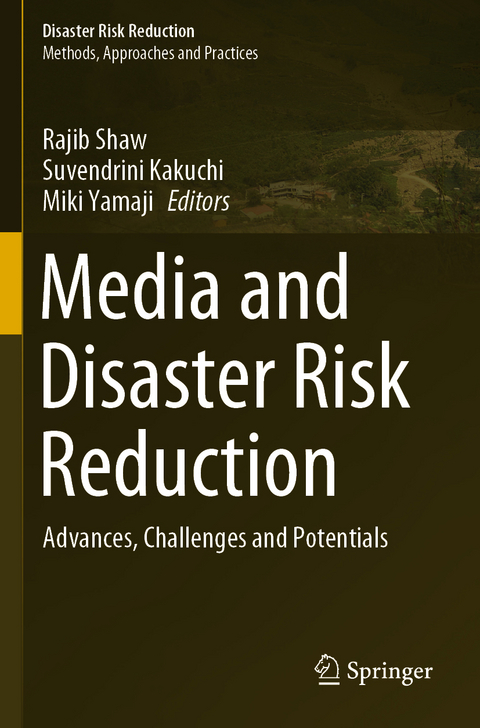
Media and Disaster Risk Reduction
Springer Verlag, Singapore
978-981-16-0287-0 (ISBN)
Media literacy has become an important issue for several stakeholders, including governments. In addition, more focus is placed on media governance to look at the priorities of disaster risk reduction initiatives within the media. All of these are considered to lead to trust in the media, which further improves people’s disaster response actions based on information from the media, before and during disasters.
Covering different aspects of media, this book is a valuable source for students, researchers, academics, policy-makers and development practitioners.
Rajib Shaw is a professor in the Graduate School of Media and Governance in Keio University, Japan. He is also a senior fellow of the Institute of Global Environmental Strategies (IGES) Japan, and the chairperson of SEEDS Asia and CWS Japan, two Japanese NGOs. He is, additionally, the co-founder of the Delhi (India)-based social entrepreneurial startup Resilience Innovation Knowledge Academy (RIKA). Earlier, he was the executive director of Integrated Research on Disaster Risk (IRDR) and was a professor at Kyoto University. His expertise includes disaster governance, community-based disaster risk management, climate change adaptation, urban risk management, and disaster and environmental education. Professor Shaw was the chair of the United Nations Science Technology Advisory Group (STAG) for disaster risk reduction, and is also the co-chair of the Asia Science Technology Academic Advisory Group (ASTAAG). In addition, he is the CLA (Coordinating Lead Author) for the Asia chapterof IPCC’s 6th Assessment Report. He is the editor-in-chief of the Elsevier journal Progress in Disaster Science and series editor of a Springer book series on disaster risk reduction. Prof. Shaw has published more than 48 books and over 400 academic papers and book chapters.Suvendrini Kakuchi is a Sri Lankan journalist and author based in Tokyo. She focuses on development journalism covering such issues as education, environment, disasters, gender and conflict resolution. Her long reporting career of more than 30 years has spanned South Asia and the Asia Pacific region, and her work comprises writing for traditional media and research-based publications and books. Among her disaster reporting assignments from the field is the Indian Ocean tsunami in 2004, the Great Hanshin earthquake in 1995, and the Great East Japan disaster in 2011. She has also produced disaster risk-reduction publications, documentary films, and journalist training, and has developed media manuals with guidelines for news editors making assignments on disasters. Miki Yamaji is pursuing her graduate studies on media and governance at Keio University. She is also a senior producer at NHK Educational, conducting several programs on disaster education. In her earlier career, she had long experience as an editor for a publishing company and also as a journalist for a newspaper company in Japan.
- Media and disaster risk reduction.- Media experiences of Asian disasters: a way forward.- Community Radio Movement in the Promotion of Disaster Risk Reduction in Indonesia.- Social media in disaster management.- Relic as record media in Japan.- Adaptation communication of indigenous and local knowledge: Can community radios be mobilized in the Hindu Kush Himalayan region?.- Challenges and lessons from reporting from Ground Zero— diaries of journalists covering disasters in the Asia Pacific.- Reinstating sustainability of community radio operation in disaster management: lessons from Indonesia and Haiti.- Creating an enabling environment for urban disaster reporting.- New Paradigms of Natural Disaster Reporting and its Risk Communication in China in the New Media Age.- The importance of reporting local disasters: lessons from Varanasi, India.- Challenges of News Gathering in a Disaster Zone: A study of Jammu and KashmirFloods.- Disaster broadcasting: challenges, evolution and lessons from Japan.- Disaster awareness and risk of foreign residents and tourists in Japan: Impact on society and role of media.- NHK WORLD-JAPAN's Challenge to Create BOSAI Culture in Japan and Across the World.
| Erscheinungsdatum | 22.03.2022 |
|---|---|
| Reihe/Serie | Disaster Risk Reduction |
| Zusatzinfo | 18 Illustrations, color; 6 Illustrations, black and white; XIII, 249 p. 24 illus., 18 illus. in color. |
| Verlagsort | Singapore |
| Sprache | englisch |
| Maße | 155 x 235 mm |
| Themenwelt | Naturwissenschaften ► Biologie ► Ökologie / Naturschutz |
| Naturwissenschaften ► Geowissenschaften ► Geologie | |
| Sozialwissenschaften ► Kommunikation / Medien ► Medienwissenschaft | |
| Sozialwissenschaften ► Politik / Verwaltung ► Politische Systeme | |
| Sozialwissenschaften ► Politik / Verwaltung ► Staat / Verwaltung | |
| Schlagworte | Broadcasting media • Community media and empowerment • Disaster Response • Media Governance • Media Literacy • Print and social media • Role of Media |
| ISBN-10 | 981-16-0287-5 / 9811602875 |
| ISBN-13 | 978-981-16-0287-0 / 9789811602870 |
| Zustand | Neuware |
| Haben Sie eine Frage zum Produkt? |
aus dem Bereich


